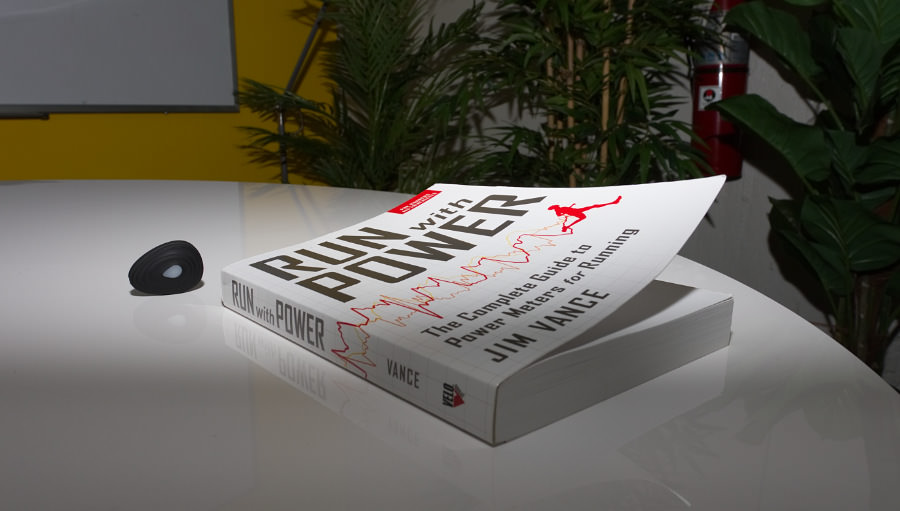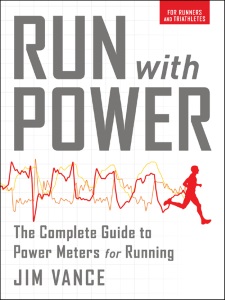Book Review: Run with Power
Jim Vance explains how to use a power meter for running performance
If you've got a shiny, new running power meter and a fresh copy of Jim Vance's highly-regarded Run with Power book — you're fully equipped to start using power data to improve your running performance, right? Well... not so fast.
These are just the basic materials required to become a student of your own running power data. As Vance clearly states in his book, your job in the beginning is to track your training runs and races while wearing your power meter, but not to alter your normal routine by introducing power-influenced workouts for "a minimum" of three months.
Don't view his suggested three-month delay as a negative. This is just the right amount of time to start building an understanding of your baseline power, and to absorb the gobs of information found in the pages of Run with Power.
Running power meters are a brand-new technology, and properly interpreting their data is an involved process. As much as you want this book to give you simple, step-by-step instructions (like a recipe for baking cookies), the practice itself just isn't that cut and dry.
Jim Vance puts great care into addressing the fact that there are many different kinds of runners at various skill levels, and in order for everyone to train with power effectively, they must be patient and adopt a structured approach. If you properly analyze your workout data to identify specific power trends, this book will deliver on the promise of making you a faster runner — courtesy of your running power meter.
...this book will deliver on the promise of making you a faster runner...
The book opens by explaining the many benefits of adding a running power meter to your arsenal, and what it provides that heart-rate, speed, and cadence sensors cannot:
- A power meter can help you improve your running form by identifying the amount of energy you're wasting on non-forward movements.
- Power quantifies intensity and eliminates other factors like weather, fatigue, and illness.
The first 50 pages cover the basics of power: what it is, how it's measured, and how you can get started using it. Well-executed graphics and charts are supplied throughout the book, and they truly help you make sense of the subject.
If you're familiar with how to use a power meter in cycling, this portion of the book may feel like a bit like review. However, even the most experienced cyclists will need to understand the fundamentals of horizontal, vertical, and lateral power in running — as these are not factors on a bike. If all of this is new to you, these chapters will form the essential knowledge to build on.
Measuring intensity with power
In chapter 4, readers are told how a power meter measures the athlete's intensity for a specific workout. It starts by establishing a power threshold value (rFTPw) for your 60 minute best effort. This number can be determined from a 30-Minute Time Trial Test, which is outlined in the book.
Subsequent workouts are measured against this as a percentage intensity, resulting in a metric called Intensity Factor. SportTracks conveniently calculates and shows this metric to you — both in the workout detail page, and in various analysis reports (using the name iFactor). This allows you to compare specific workouts and recognize trends over time, and to ensure that the intensity you plan to achieve is actually met without doing any math.
Becoming a more efficient runner
The 30 pages starting at chapter 5 are perhaps the most important part of the book. It's also the part that you'll want to spend the most time digesting. Vance walks you through stride mechanics and clearly explains how efficiency and power output change with runner speed. Every power metric is explained in detail, and several examples serve to illustrate why you should care about them, and which changes indicate actual performance improvement.
Chapter 5 is also home to perhaps the most important metric in the book: EI @ FT (Efficiency Index at Functional Threshold). This is a measurement of your speed per watt at threshold pace. Over time, if you can go the same speed and use fewer watts, or get faster by using the same amount — you will be getting more efficient.
Your EI @ FT is obtained from the final 20 minutes of a 30-minute Time Trial test. If you execute one of these TT runs, your EI @ FT will automatically be calculated by SportTracks. Just click (or tap) on the pace Total Block at the top of the workout detail page until you see Efficiency Index. That's your number. Did we mention SportTracks offers a risk-free, 45-day free trial? ;)
Training plans and advanced topics
The remainder of the book feels like it's downhill to the finish. Vance covers the basics of power zones and makes a firm case as to why you shouldn't use them until you're ready. He also covers general training concepts as applied to using power meters. There's a chapter on training load as well.
The final part of the book features detailed training plans for utilizing power to train for the following races/times:
- Sub-16 and sub-18 minute 5Ks
- Sub-32 and sub-40 minute 10Ks
- Sub-120 and sub-140 minute half marathons
- Sub-2:30 and sub-3:30 marathons
Once again, all of the metrics covered in the book are cooked into SportTracks, so you just need an understanding of the "why", rather than the "how".
In summary
If you're curious about incorporating power into your run training, we think Run with Power is a great book to pick up. Here are two of the most important takeaways:
- Intensity is the key to higher fitness, not volume; otherwise ultra-runners would win every race from 100 meters to 100 miles. This is related to the idea of training specificity. On some level this is a basic concept, but it's presented in a way that relates particularly well to power.
- Running power analysis must include efficiency analysis because of the way power is transferred to forward movement through leg motion. This isn’t the case in cycling, where power is transferred directly to the bike. If you're a cyclist watch out for this!
This was the first book ever published on the topic of run power data, and the nascent aspect of this technology makes comprehending it all the more difficult. Run with Power acts an experienced mentor who helps you connect the dots.
As new as running power may be, it's undeniable that it has something potent to offer. If you're willing to put in the time to learn how leverage this data, it might help you become an even faster runner.


